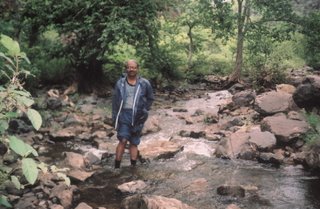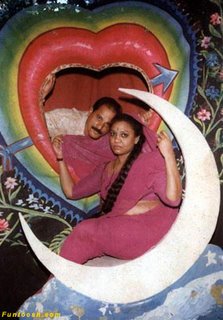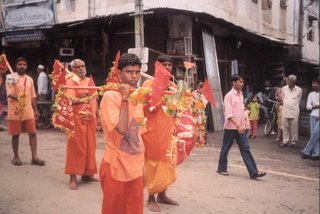The death of a 200 year old Banyan tree in Mhow (MP) India
 (Monday 21 Aug 2006)
(Monday 21 Aug 2006)When people think of Mhow and especially so when they think of Mhow bazaar they think of the banyan tree somewhere midway on Main Street (Bombay Bazaar). Whenever I passed on the road below it, I felt a coolness. And the small Bhairav temple below it gave it a nice ambience. If one passed below it when the sun was about to set one had to be extremely careful for one of the birds could decide to drop something which would land with a plop on one's helmet or shirt. At this time one could hear the chatter of thousands of birds as they perched on the branches and prepared for bed.
 (Monday 21 Aug 2006)
(Monday 21 Aug 2006)Well, all that changed last Friday. I was in Malwa Market getting some pages xeroxed at Inder Photo Copy when the electricity failed. I felt very irritated. But when Lalit, who works there, told me that the banyan tree on Main Street had fallen I felt very sad. I took a visit there and I could see it leaning precariously. The local authorities had arrived and were busy ensuring that it did not crash to the ground and cause loss of life and property. The temple at the foot of the tree had developed cracks due to the huge pressure on it and Karachi Tailors was also in a bad shape.
 (Monday 21 Aug 2006)
(Monday 21 Aug 2006)Locals of Mhow tell me that this tree is more than 200 years old. That means that this tree was there even before the Battle of Mahidpur in 1818 when the British under John Malcolm defeated the Holkars who ruled Indore. It was as a result of this loss that the Holkars had given Mhow to the British under the treaty of Mandsaur to be developed as a Cantonment.
My childhood classmate Raj who lives nearby on Bhoj Marg took me there on Sunday when I had gone to his house for lunch. I clicked some photographs with my Yashica MF2 camera. I felt sad when I saw the condition of the tree. Can't it be transplanted, I asked myself. I think that they had transplanted a huge banyan in Chennai some years ago. As it would take some more days for me to finish the camera roll I went to Pradeep Studio on Main Street and asked Arshad if he could take some pictures for me with a digital camera. He promised to do so. And when I went today he gave me the photographs which I have uploaded here.
Sanjeev Kumar of Kumar Radios told me about a Parsi couple with a Mhow connection who visited Mhow after many years and spent a fair amount of time below the tree while the lady sketched it.
It is sad when a tree dies. During last year's rains the Jungli Jalebi tree which stood near the bus stop at Dreamland Chowk fell down. I remember seeing that tree from my childhood days.
 (Thursday 24 Aug 2006)
(Thursday 24 Aug 2006)A banyan tree needs space for its aerial roots to come and enter the earth. This heritage tree of Mhow did not have the space to do so. A few days ago I was standing on the banks of the Gambhir river near the Khadey Hanuman temple and I saw a huge banyan tree there with a large canopy and many columns of aerial roots embedded in the ground. I also remember the banyan tree with the huge canopy in Beircha Lake. And there is one on General's Road too. It is just before the turning for Dunn Marg as we go from the Ambedkar Garden towards Signals Vihar. It also doesn't seem to have sufficient space for its roots to enter the ground - but it doesn't seem to be in as much danger as the fallen tree. I remember the banyan tree which used to stand near the bust of Jawaharlal Nehru opposite the Bank of India. Part of Malwa Market is there now. The tongas used to stand below in the shade. Now the tongas are gone and so has the tree.
 (Thursday 24 Aug 2006)
(Thursday 24 Aug 2006)







